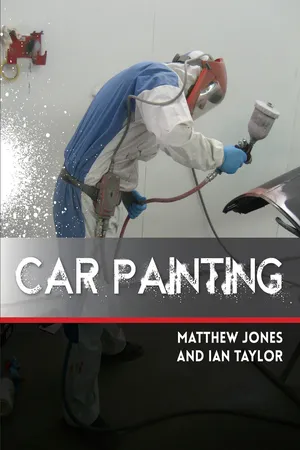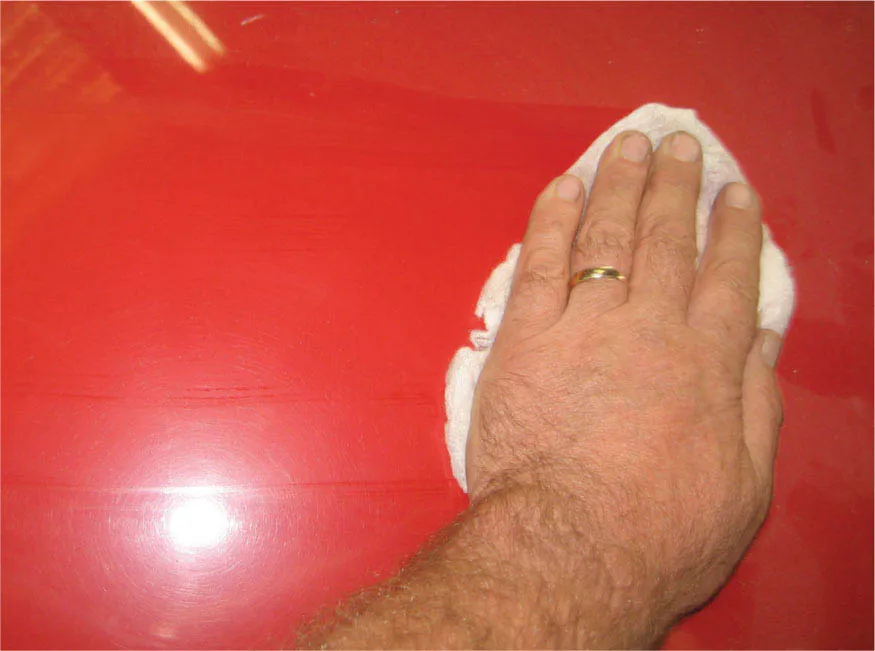![]()
CHAPTER ONE
ALL ABOUT PAINT
This chapter answers the following questions:
- What paint do I have on my car (water-based, polyurethane, enamel, cellulose or two-pack)?
- What products can I apply to my vehicle (without causing a damaging chemical reaction)?
- How do I select the right colour (implications of a full colour change, colours that hide the most sins, colours that are difficult to maintain)?
- How do I match paint (how to match colours, difficult colours to match, find out what your car’s original colour was)?
- How does it all work (paint chemistry basics)?
- Paint and the law – what do I need to know (EU legislation regarding volatile organic compounds or VOCs)?
- Are there any health and safety implications (handling paint, skincare, ventilation)?
Use a white cloth and lacquer thinners to wipe an inconspicuous are of your car’s paint to see what kind of paint you have.
Before you can begin to apply paint to your car, you need to start by discovering the chemistry behind the process. This should help inform your spraying technique. It is also essential to know what kind of paint you have on the vehicle as it is this that will determine the extent to which you strip your car. Then there’s the law – painting throws up problems that must be addressed and researched before you begin.
FIND OUT WHAT PAINT IS ON YOUR CAR
Knowing what sort of paint your car is finished in will inform how you use this book. Discovering its type is a pretty straightforward process, but it must be done before you begin any work or buy any paint or tools. All you need is a white cloth, some lacquer thinners, 800-grit (or finer) sandpaper and a clean, inconspicuous area of painted bodywork, like the inside of a boot lid. Now dab your cloth with the thinners and rub.
- If colour comes off immediately or the paint begins to wrinkle, you have enamel paint.
- If colour only comes off after a lot of rubbing, you have lacquer paint.
- If nothing comes off, you have urethane paint.
- To see if the finish includes a clear coat, lightly sand a different area. If the dust is white, you have clear coat; if it is the same colour as the car, you do not.
While there is a chance that your car might already have been repainted at some point in its life, it is also worth getting some historical perspective on the sort of finishes that were popular throughout history:
1940s: enamel and lacquer-based paint (quick to apply, requires little finishing after application).
1950s: nitrocellulose paint/lacquer (requires several coats, then a clear coat on top; fast drying, easily correctible and gives a deep, glossy finish).
1960s: urethane and polyurethane paint (quick to dry and apply, durable and easy to correct).
WHAT DOES THAT MEAN?
It’s a matter of compatibility. Assuming the surfaces are prepared properly and you spray in the correct conditions (more on that later), you can lay enamel over lacquer. However, if you apply lacquer onto enamel, the surface will almost always wrinkle and get damaged.
The problems are a matter of chemistry – the solvent base for lacquer is far too strong for the softer materials in enamel paint. But compatibility issues do not end there. Paint systems are much like car systems. In the same way that you cannot bolt a Mercedes’ cylinder head onto a BMW engine block, there is a good chance you cannot use a BASF thinner with, say, a U-Pol paint; even more so considering increasing health and safety regulations imposed on paint manufacturers. Developers might even change application hardware, like spray guns, and the method of application to meet the required standards, which is an increasing imposition as legislation tightens in Europe.
There is a mass of information about automotive paint and its chemical composition, and you may wish to read more about it, but this book focuses on learning how to apply the paint itself, so the following information is a very brief, very basic guide.
Automotive paint is made up of three basic ingredients:
- Pigments (colour)
- Binders (adherents)
- Solvents (thinners)
It works like this:pigments and binders are solid substances, and solvents allow them to be turned into a liquid and sprayed onto your car. Lacquer paints have lacquer thinners, while enamels and urethanes have reducers; but all of them evaporate, leaving the layer of solid colour on your car.
VOLATILE ORGANIC COMPOUNDS (VOCS)
But along with overspray, it is the solvent evaporation component of the chemical process that causes the most environmental problems and health risks. In 2001, European legislators stepped in to ensure that any paint products that produced significant emissions of ‘volatile organic compounds’ were regulated. VOCs are defined as any organic compound with an initial boiling point less than, or equal to, 250ºC (480ºF) measured at a standard pressure of 101.3kPa.
In plain English, a VOC in the world of car painting is a solvent or paint particle that mixes with nitrous oxides and produces ozone. When paint particles or solvents rise into the atmosphere (caused by overspray, which is paint sprayed that does not adhere to the car, and evaporation, respectively), they contribute to air pollution. The European Parliament has stipulated that the VOC content of certain paints and solvents should be ‘reduced as much as is technically and economically feasible taking into account climatic conditions’.
Limiting VOC emissions has been the impetus for lots of technical innovation in paint and paint booth-related products. To meet the requirements, paint shops have fitted down-draft ventilation and special air-filtration systems to stop VOCs escaping. Also, a special high-volume low-pressure (HVLP) painting system has been developed that produces 64ft3 per minute of air warmed to 32ºC (90ºF) at 5lb/in2. It means less paint bounces off the car and into the atmosphere, and offers the advantage that you will need to use fewer materials in the process. An HVLP gun can transfer up to 80 per cent from the gun to the bodywork, while a traditional system transfers around 40 per cent, which is barely more than an aerosol can.
Paint itself has also been developed to fall in line with the restrictions, the most notable product being waterborne finishes. As the name suggests, this uses water to suspend the paint pigments and deliver them to the surface to be covered, not solvents. Nearly all waterborne paints use a basecoat colour covered by a clear coat and once it dries, the chemical process is effectively finished. But with traditional finishes, the solvent gases continue to work through the surface for up to six months – known as the ‘flash time’ – which can cause problems if the surface is blocked by anything like detailing and polishing waxes.
This colour chart illustrates the various hues available.
It sounds like an excellent solution – and in terms of environmental impact it is a vast improvement – but it is not without fault. Despite reduced VOC levels, waterborne paint has plenty of lethal chemicals in it, so you need a respirator on at all times. It is also slow to dry, expensive and requires special materials for you to apply it (there will be more on this later).
Luckily, most major paint manufacturers sell a low-VOC, solvent-based coating that meets all the legal requirements. Also, you can buy chemical additives for some solvent-based paints that alter it so that it complies with VOC content.
If you are determined to create a finish as original as possible, you will be pleased to learn that the European Parliament has also allowed member states to grant individual licences for limited sales of products that do not meet the VOC criteria. It stipulates that it must be ‘for the purposes of restoration and maintenance of buildings and vintage vehicles designated by competent authorities as being of particular historical and cultural value’. That generally means the materials will be expensive, but useable for the DIY enthusiast and useful if you want to complete a faithful restoration.
COLOUR SELECTION
The fastest way to get a steer on your car’s colour is to consult the Vehicle Identification Number (VIN) plate, which is a small tag located on your car. Its location varies from car to car, so it is best to consult a car club or enthusiast to advise you. Deciphering this, and discovering which section of the VIN code relates to paint code, depends on the manufacturer. In the absence of an expert, copy all the numbers and letters down, then take it to a paint shop to decode.
But be careful – someone may have changed the car’s colour during its lifetime. It is also possible that it has been incorrectly tagged at the factory, though unlikely. As a fail-safe, it is a good idea to tell the paint supplier the basic colour of your paintjob – red, blue, green, etc. – and they will be able to tell if you if it matches up to the code before it is mixed in bulk.
Unfortunately, the complications and scope for error do not end there. If you are painting a more modern classic, there may be several formulas that are quoted for any one colour. It is caused by the automated paint process at the factory – at the production line a batch of, say, twenty cars will be painted one colour, then machines will be cleaned and they will spray the next twenty cars in a different colour. Very slight contamination from other colours and cleaning agents can cause variations from the colour as it appears in the tin.
Black is one of the hardest colours to paint perfectly as it reflects everything.
This is not much of an issue if you plan to fully repaint your car, but if you are attempting a localized repair, it is important that it is matched as closely as possible. Sometimes the car’s position on the line – and subsequent variation in paint colour – is listed in the paint code in up to ten different variations; other times it is not at all. If not, find the prime colour and check at a paint shop to see if they have colour chips that show the variations, then match up accordingly.
If you have single-stage or two-stage paint, you also have the option of using a spectrometer – it is the size of a shoebox and has a port on one end that shines a light on the surface, takes a very sophisticated reading of each wavelength of light reflected off the object and works out what colour it is. It is an expensive piece of kit, it requires you to send off a sample section, like a petrol-filler flap, and you will not be able to use it on more complicated finishes like metallics, but it does give a very accurate reading.
CHOOSING A NEW COLOUR
If you are fully repainting your car, you have the option of choosing an entirely new colour. But undertaking a full colour change will greatly increase your workload – more of the car will have to be taken apart, such as the engine if the bay is finished in body colour, as well as...



